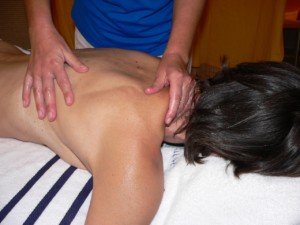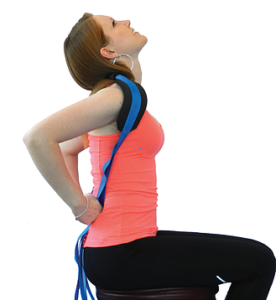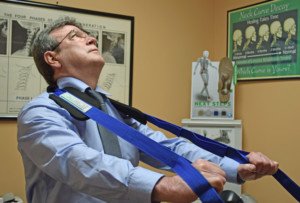
Muscle knots can cause anxiety over possibly having a serious disease, but it’s a benign condition that has different causes and treatments.
Do not panic if the professional who’s massaging your back, shoulders or neck suddenly says, “You have a big knot in your muscle.” Don’t worry; this doesn’t mean a serious disease.
The massage therapist will then proceed to “work out the knot.”
In minutes you’ll feel relief. Don’t let the layperson term “knot” scare you.
What is a muscle knot?
• “Muscle knots are areas of a muscle that are excessively tight and overly contracted, many times to the point of being painful,” says Dr. Tom Carpenter, corrective exercise specialist, certified personal trainer and chiropractor, inventor of Stand Corrected™, a portable harness-like stretching tool that helps alleviate back, neck and shoulder pain. The contracted muscle fibers are not able to release.
• They thus remain in a tightened or tense state.
• They are very local, and the spot that’s tender upon pressing has a small surface area – up to the size of a quarter.
• “Some knots are only painful when direct pressure is applied, and these would be considered to be latent trigger points,” says Dr. Carpenter.
• There may be multiple knots in a specific area.
• The medical term is myofascial trigger point.
Origin of Muscle Knots
• “Muscle knots can be caused by overuse, heavy lifting or repetitive movements,” says Dr. Carpenter.
• “Also prolonged poor posture from, for example, too much texting or being hunched over a computer resulting in strains which produce tight and knotted muscles.”
• Dr. Carpenter also explains, “Spinal misalignments can many times result in associated myofascial trigger points as well, and this should be checked by a chiropractor.”
• Don’t be surprised if your massage therapist, upon beginning to work your neck and shoulder area, asks if you’ve been under a lot of stress lately.
Dr. Carpenter points out, “Emotional and mental stress shouldn’t be ruled out either when experiencing this problem.”
• Nutritional deficiency
Treatment for Muscle Knots
“Some solutions would be to massage the painful areas and try to work them out as well as using a heat pad on the area, assuming the pain is not from a recent acute injury,” says Dr. Carpenter.
Massage therapy such as deep tissue massage will work wonders. The caveat is that it’s not cheap.
However, rather than having hour-long massages you can have 30 minute sessions to save money yet still reap the treatment benefits.
As the therapist “works out” the knot, it usually hurts (tenderness), but then it starts feeling good. The therapist can then press upon the area where the knot was, and you’ll no longer feel the pain.

However, rather than having hour-long massages you can have 30 minute sessions to save money yet still reap the treatment benefits.
Foam rollers. If you use a gym, you’ve probably seen on many occasions people rolling a body part against a foam roller on the floor.
I’ve done this with the area where the butt muscle ties into the upper hamstring (“glute tie-in” or “hamstring-glute junction”).
And it actually works when you’re patient and relaxed, rhythmically rolling.
Improve posture. Avoid slumping in your computer chair and slouching while standing.
“Gentle stretching of the muscle can also be helpful,” says Dr. Carpenter.
Take your hands off the treadmill. Holding onto the treadmill creates an unnatural walking gait that skewers posture.
This can contribute to or cause undue tension in the neck, shoulder and upper back muscles.
If you think you’ll fall off without holding on, slow the speed and/or lower the incline.

Stand Corrected™
Dr. Carpenter recommends seeing a chiropractor if the above treatments fail to resolve your muscle knots.
Muscle knots are very common, especially in athletes, workout enthusiasts and muscle builders. Do not fear them; just treat them.

Photo credit: Aleesia Forni








































